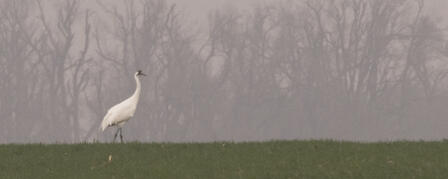WHOOPERS CRANE THEIR NECKS TOWARD KANSAS

Oct. 27, 2011
One bird sighted at Quivira National Wildlife Refuge, two at Cheyenne Bottoms Wildlife Area
PRATT — Northely winds accompanying a Canadian cold front the week of Oct. 17 moved whooping cranes south from Canada toward their wintering grounds at Aransas National Wildlife Refuge on the Texas Gulf Coast. As of Oct. 19, two cranes were sighted as far south as northern Texas. Additionally, there was a single whooper observed at Quivira National Wildlife Refuge, near Stafford in central Kansas, the same evening. A week later, two birds had been spotted at Cheyenne Bottoms Wildlife Area, near Great Bend. Although U. S. Fish and Wildlife Service (USFWS) staff believe the migration is about two weeks late this year, they can be expected to show up in Kansas at any time through the next several weeks..
Many Kansans look forward to the fall migration of these magnificent birds through the state. Fall records indicate that most pass through Kansas between Oct. 17 and Nov. 10. Sighting a whooper is a special experience for both casual and avid bird watchers.
Each autumn, whooping cranes migrate south through Kansas from their Canadian nesting grounds at Wood Buffalo National Park in the Northwest Territories. The Aransas-Wood Buffalo population (AWBP) of whooping cranes rebounded from 263 in the spring of 2010 to 279 in the spring of 2011. With approximately 37 chicks fledged from a record 75 nests in August 2011, the flock size should reach record levels of about 300 this fall. Twelve whooping crane juveniles were captured and fitted with transmitters in Wood Buffalo National Park in August, bringing the total number of radioed birds to 23.
The fall migration is monitored through a cooperative program supervised by the USFWS. Many people in Canada and the United States will participate in the effort, which will provide the USFWS with records of whooping crane numbers and movements. Members of conservation agencies along the migration route assist with the tracking program.
The Kansas Department of Wildlife, Parks and Tourism (KDWPT) is one of the agencies involved. KDWPT encourages anyone who has spotted a whooper to contact their local natural resource officer or KDWPT office. Sighting information will be used to alert managers of key areas along the flyway — such as Quivira and Cheyenne Bottoms Wildlife Area in central Kansas — and to provide sighting records for the Whooping Crane Recovery Plan and for whooping crane research in the U.S. and Canada.
In the 1940s, only 16 whoopers remained in the world. Today, there are 157 in captivity and 414 in the wild, bringing the world population of whooping cranes to 571. For more information, visit the U.S. Fish and Wildlife Service website at www.fws.gov/midwest/whoopingcrane.
-30-









